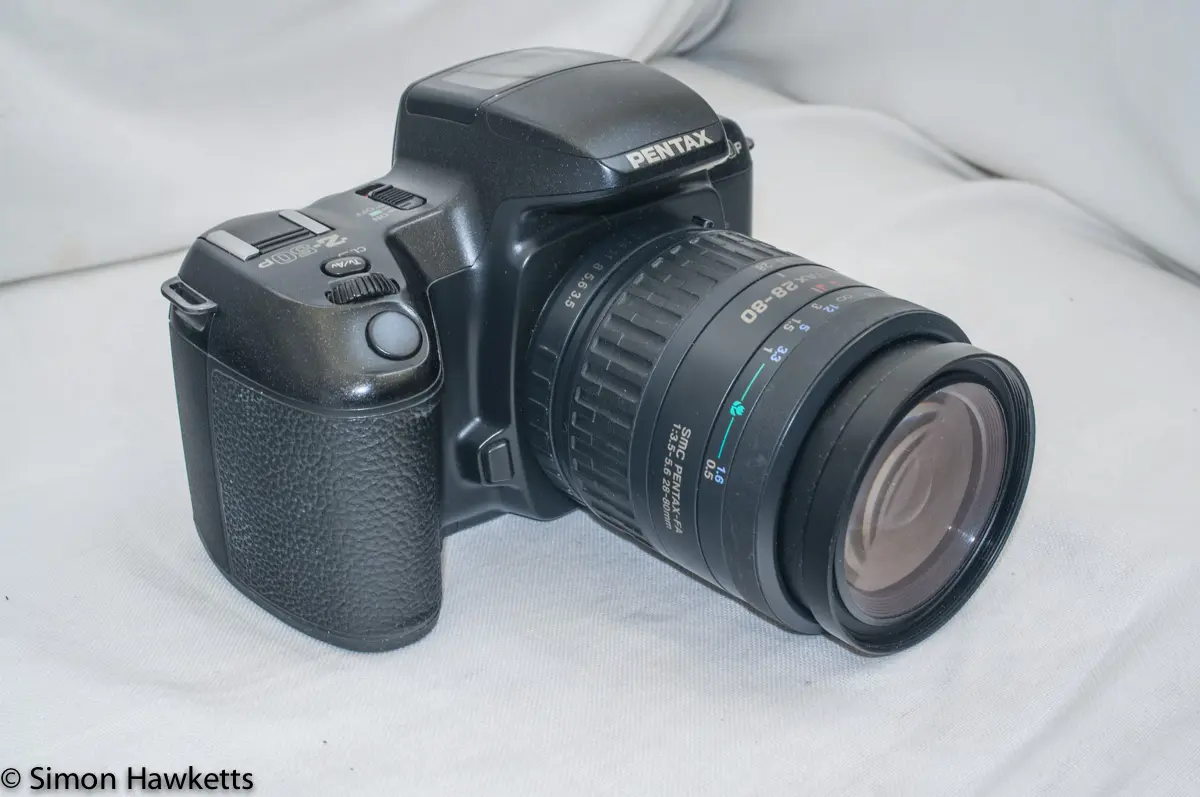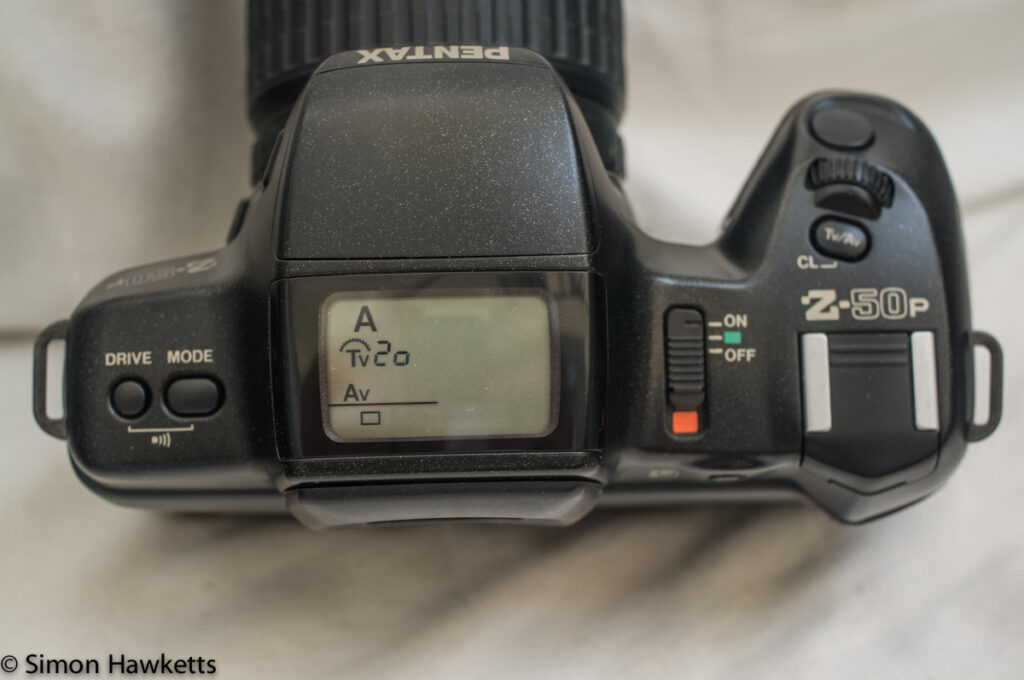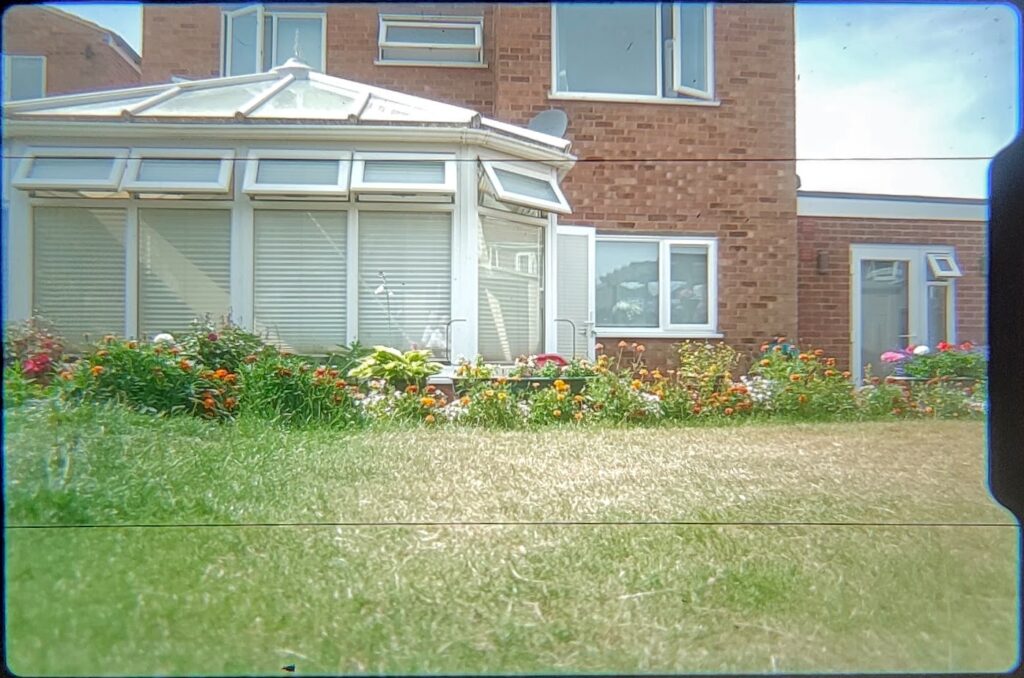The Pentax Z-50P autofocus SLR camera – a great beginners film SLR
The Pentax Z-50P was one of the later additions to the Pentax Z series of cameras when it was introduced in 1994, but provided a good mix of features for a reasonable price. Today it offers the same good range of features for anyone either starting out in film photography or a seasoned film snapper, but on the second hand market provides them at a frankly silly price.
My Pentax Z-50P camera
I purchased this camera via eBay as an offer to a seller who had two Z-50Ps for sale. The cameras were in a standard auction, starting at £10, and I’d intended to place a bid at the last minute to try to get them for that price. Unfortunately, I forgot the time, missed placing a bid and only remembered a few minutes after the end of the auction.
As well as being annoyed that I’d missed the auction, I was doubly annoyed because no one else had placed a bid, so I would have been able to purchase them for £10. However, because no one had bid it did mean they were available for an offer, so I contacted the seller and after some back and forth in the end we settled on £15 for both units. That’s a pretty good deal, because I can probably sell the second unit for more than that once I confirm it’s working.
The seller sold the units as untested because the batteries fitted were flat, but I was pretty confident that they would be OK, as I’ve not yet come across a Z-series Pentax that doesn’t work. That doesn’t mean of course that they can’t go faulty, but I’ve not yet had a faulty one.
Sure enough, when they turned up, and I slipped a new battery in, they both sprang to life and everything seems to be working. They also both look in fantastic condition and were supplied with all their ‘fixtures and fittings’ i.e. the eyepiece cover, hot shoe protector, strap, camera manual etc.
Another interesting point about the two units is that the serial numbers are within only a few digits of each other, 6348226 & 6348213, so they were probably purchased together from new.
Pictures of the Pentax Z-50P








Description of the Pentax Z-50P
The Z-50P autofocus SLR is very similar is style and size to all the other units in the Z-series. It has a solid plastic body over a metal framework with a good size hand grip, controls that fall easily to hand, and a built-in pop-up flash mounted above the lens mount. The style is a rather typical 1990s look with quite curved lines – certainly more attractive than some of the very boxy designs on the 1980s.
I’d say the camera is the same size as the Z-10 and Z-20 and slightly smaller than the flagship models Z-1 & Z-1P. It is the same sort of weight as the Z-10 & Z-20 as well, which means, although it’s not lightweight, it’s also not like carrying a tank around.
The Z-50P has a metal, KAF2 mount which supports a whole range of autofocus Pentax lenses with effects such as Zoom Clip mode and Image Size tracking when a lens which supports these functions is used. It’s also possible to use any manual focus K mount lens, and the camera will use its autofocus sensor to tell you when the correct focus point has been achieved when used with a manual focus lens.
Control Layout
In common with all the Z-series, the Pentax Z-50P features an LCD panel on the top of the camera in the place the flash shoe would normally sit. This characteristic look seems a bit odd at first, but when you get used to it, it actually makes a lot of sense because it means the flash shoe is moved off to the side of the camera above the hand grip. This results in the light coming from a slightly different angle when an external flash if fitted in the shoe, and therefore reduces the possibility of red-eye.
With the LCD panel in the approximate middle of the camera top, there are mode and drive switches to the left and the on/off switch to the right of that panel, and then a group of three controls above the hand grip. They are the shutter release button, a rocker switch used to change various settings and a function button labelled Tv/Av.
On the back of the camera, to the right of the eyepiece is an exposure compensation button, marked +/-, and on the bottom trim is a slim slider switch which is marked with a P and one end and a rectangle at the other. This is the switch that sets the camera into Panoramic mode, more on that later.
On the front of the camera are two more controls; an MF/AF slider on the right-hand side of the lens mount, which switches between autofocus and manual focus, and then the lens release button, which is a push button on the left-hand side of the lens mount.
Viewfinder
The viewfinder in the Z-50P is slightly different from the non P versions of the Z-series because it has lines marked for when the Panoramic option is enabled.
The Panoramic option was something Pentax added to some of their cameras in the 1990s, and basically was an attempt to produce images with a wider aspect ratio than standard 35 mm film produced.
A normal 35 mm frame is 24 mm x 36 mm, which is an aspect ratio of 2 x 3. The Panorama option added blinds at the top and bottom of the image to make a wide aspect ratio. This was at the expense of reducing the amount of film used to capture the image of course, and I’m not sure how popular it was, but the viewfinder is affected because there are lines which show how the composed image will look, and these can be seen in the image here.1
Although it’s not easy to see it in the picture here, the viewfinder also shows the focusing spot in the centre of the view, and the area to the side which displays the exposure and other data. By the time this camera was made in the mid 1990s there was quite a reasonable amount of data visible in the viewfinder including the shutter speed, aperture, exposure compensation, and a symbol to show that the autofocus had locked.
Exposure Modes
The exposure modes a camera has lie at the heart of taking good photographs, and the Z-50P is well-equipped considering the entry level position it holds in the Z-series as a whole. The top camera in the series, the Z-1 had a total of six different modes, and the Z-50P doesn’t match that, but it does offer four modes which are:
- Program mode, where the camera sets both the shutter speed and the aperture of the lens and controls the exposure completely. The photographer still has the option to shift the chosen setting with the toggle control if they want to.
- Aperture Priority AE, where the photographer sets the lens aperture and the camera automatically adjusts the shutter speed to achieve the correct exposure. The Z-50P has a neat trick however, because a press of the Tv/Av button just below the toggle switch changes this behaviour so that the shutter speed can be changed, and the camera automatically changes the aperture. In effect, the camera can be toggled between Aperture Priority and Shutter Priority.
- Manual, where the photographer is in full control of both aperture and shutter speed. The camera shows a useful little vertical scale in the viewfinder (and on the top LCD panel) which shows how far out the exposure is, allowing the photographer to shift either aperture or shutter speed. The Tv/Av button again toggles the control to decide which.
- Bulb, where the shutter stays open for as long as the shutter release is held down.
To select the Exposure mode, the ‘Mode’ button is held as the toggle switch is pushed to the left or right and the selected mode is shown on the top panel LCD. As is common with virtually all electronic cameras, the shutter release button is half pressed to enable the exposure system to operate.
On the back of the camera is an exposure compensation button, which allows up to 3 stops of either + or – compensation to be applied to the exposure. The display for this is shown both on the top LCD and as a scale down the side of the viewfinder. This works in both Aperture priority or Program mode, but not (obviously) in Manual mode, where the photographer is in full control of the exposure anyway.
The other half of the exposure modes of course is the ability of the camera to measure the light in the scene. The Z-50P does this with a 6 segment light sensor mounted in the prism holder, which measures the light directly through the camera lens. This means it will automatically compensate for filters fitted to the lens or any macro extension tubes etc used.
When the camera is used in one of the Automatic Exposure modes the light is measured across the whole of the scene, but when Manual mode is selected the metering switches to spot measurement and uses the central area of the frame to measure the light.
The camera detects the film speed using the DX code system that film canisters are marked with. Although this is a good system that means the photographer doesn’t need to remember to set the film speed, the camera can’t be overridden on this setting, which means if you use film that isn’t DX coded the exposure system will rate the film at 100 ISO.
At the time the camera was made, this probably wasn’t an issue since all film had DX coding and the camera is aimed at the sort of photographer who wouldn’t want to override that setting, but it may prove to be a problem for a modern photographer who wants to try film photography.
Film transport and drive modes
In common with the rest of the Z-series of cameras, and indeed most autofocus cameras made at the time, the Z-50P is fully automatic when it comes to loading the film and winding between each frame.
The picture above shows the film chamber, and to load a film all that’s necessary is to drop the cassette into the left-hand slot where the DX coding pins are protruding and make sure the end of the film extends across the back of the camera to where the take-up spool is fitted. Then, once the back of the camera is closed, the film is automatically wound forward to the starting frame and the frame number is shown on the top panel LCD screen.
Once the film is loaded, the camera automatically winds the film forward by the correct amount as a picture is taken.
The Z-50P has 3 different drive modes that can be selected by pressing the ‘Drive’ button on the left-hand panel and toggling them with the rocker switch. As each mode is selected, a section of the top panel LCD shows which drive mode is selected. The options are:
- Self-timer mode, where the camera waits 12 seconds after the shutter release is pressed before the shutter is actually fired. There is a count-down beep which changes in rapidity as the last few seconds count down.
- Normal single shot mode, where the camera takes one picture and winds the film forward for the next exposure
- Multi frame mode, where the camera continues to take pictures as the shutter release is held down. This seems to run at about 2 frames a second.
Once the last picture has been taken, the camera automatically rewinds the film back into the canister ready for development.
The camera also provides the option to wind back the film mid-roll using a small switch at the bottom of the side where the back door catch is. This would need to be pressed with a sharp point because it’s designed, so it can’t be accidentally operated.
Focusing the Z-50P
The camera is equipped with a focus motor which will drive almost any autofocus lens made by Pentax over the last 50 years. Although the screw thread driven system used by Pentax is slower than the modern ultrasonic motors used by many manufacturers, it does mean that anyone with vintage Pentax lenses can still use them on relatively modern cameras.
In fact, although I don’t own a new Pentax DSLR, my K5 model will also still focus any of the film era autofocus lenses I own.
Anyway, back to the Z-50P. The autofocus system is driven by a single focus sensor in the centre of the viewfinder, and although the system is quite old by today’s standards, I find it to be perfectly usable in normal levels of light. I think that working in low light levels is one of the factors that differentiate modern autofocus systems, but when using film cameras, which are unlikely to be used in very poor light, it’s not so important.
Other camera functions on the Pentax Z-50P
There are other functions provided on the Z-50P which are pretty useful.
On the main On/Off switch there is a setting between Off and On which is marked with a green rectangle. If this is selected the camera is put into Green Mode which is ideal for beginners or people who want a good quality ‘snapshot’ camera. In this mode, the camera takes care of the exposure using Program mode, but the option to shift the exposure is disabled. Also, the exposure compensation option is also disabled, so the camera is left in full control.
For situations where there is not enough natural light to take pictures, or for occasions when a fill light is needed, the Z-50P provides a pop-up flash in the prism bulge above the lens. This flash needs to be raised manually by the photographer, but there is a warning symbol in the viewfinder and LCD screen when the camera detects that it’s required.
The Z-50P is also equipped with an accessory socket on the lens housing that took a variety of plug in accessories like cable release etc that were made for the whole Z-series of cameras.
Pentax Z-50P Specifications
- Pentax Z-50P autofocus 35 mm camera
- Pentax KAF2 Metal Lens mount
- Top mounted LCD info screen
- Program, Aperture Priority, Manual and Bulb AE modes
- +/- 3 stops of exposure compensation
- Metal vertical shutter with speeds of 30 sec to 1/2000 sec
- Single shot or 2 fps auto drive
- Auto film loading and rewind
- Panoramic pictures with 13 x 36 format
- DX coded film without override
- ISO 25 to 5000 – non DX coded rated at 100 ISO
- 12 second self-timer with audio count down
- 6 segment TTL exposure meter in AE
- Spot metering in Manual mode
- Built in Pop-up Flash
- Powered by single 2CR5 battery
- Green mode for fully automatic operation
- Informative viewfinder with exposure and focus information
- Panoramic guidelines in viewfinder
- AF / MF selection on lens mount
Manual for the Pentax Z-50P
I’ve recently scanned the camera manual for the Z-50P to include in the camera manuals section of the site, so I’m including it here as well.
My assessment of the Pentax Z-50P
This assessment of the camera is based on my initial viewing since I received it and will be updated when I take some images with it. We have just booked a holiday, and I’ve earmarked the Z-50P to be one of the cameras I take with me on that trip, so hopefully in a couple of months I’ll be able to link to some samples and update this piece.
As it stands, I think this is a wonderful film camera to purchase if you want to try out film photography or reacquaint yourself with it if you switched to digital many years ago but yearn to re-explore film. It has a good range of options and is sturdily built, and, assuming it is as good as the other cameras in the Z-series, should give a great account of itself.
Being fitted with a Pentax K mount means that there are a huge range of lenses that will work with the camera, and virtually all Pentax autofocus lenses will focus correctly with the Z-50P. I’ve tried my 10 – 24 mm super wide angle lens on it, and it works well, although since that lens is designed for an APS-C sensor it vignettes severely at the 10 mm end.
If you don’t have any Pentax K mount lenses, it’s possible to pick up good condition second hand Pentax autofocus kit lenses for only about £20, so for an outlay of about £60 you could get a 28-80 lens, a 70-200 lens and the Z-50P body and have a full film kit.
The only downside I can see is the fact that you can’t override the DX coding – if that would be a problem for you, then I would recommend the Z-20 or if you can find one at a reasonable price, the Z-1 or Z-1P.
- I believe later Pentax cameras that had the Panorama function actually dropped blinds over the viewfinder to show the effect. [↩]
Discover more from Everything Vintage
Subscribe to get the latest posts sent to your email.






